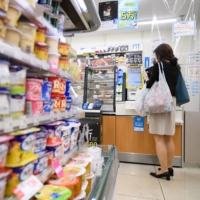New York – With a state of emergency in place in Tokyo due to the COVID-19 pandemic, the Olympics host city hasn’t been as hospitable to the international press as it had hoped.
In a so-called Olympic bubble, separated from the city at large and prohibited from going too deep into the Olympic Village, the foreign press has had to cover what’s close to it — mainly, Japan’s ubiquitous konbini (convenience stores).
Like first-year foreign exchange students, they documented their findings on social media in formulaic, if slightly banal, photographs. Food and drink were splayed out on tables, or held aloft from the seats of a competition. If hints of the pandemic failed to materialize in other media, then it was through these konbini-related images that glimpses of reality parsed through: absurd and dystopian.
Breakfast of champions ? Quite tasty. #Tokyo2020 pic.twitter.com/QIWFNj2bLk
— Frank Gunn (@frankgunnphoto) July 25, 2021
In most Olympics, the press corps report on the sporting events but also fan out across the city, tapping “into the local color of the host city,” as John Otis writes in The New York Times. At the 1964 Tokyo Olympics, it was the postwar infrastructure, built from the rubble of the war, “the dazzling roads and the dazzling buildings,” wrote E. J. Kahn in The New Yorker, that drew the awe of foreign correspondents.
This year, however, the Games were set during a pandemic. Journalists had to adhere to a 68-page playbook, that outlined carefully choreographed and restricted movements. For 14 days after arrival, members of the press were banned from public transport, interviews with spectators, and “must not walk around the city or visit tourist areas, shops, restaurants or bars, gyms, etc.” For food, the options were minimal — restaurants in accommodations and venue dining areas; if those are not available, “you can buy food at convenience stores,” the playbook states.
Tokyo was then seen from a cocoon, observed through the window of a bus or the fence of an Olympic venue. And it was experienced largely through the konbini: There for a moment of relief or as a connection to civilization, and a means to transcend the sterile venues and shoebox-size hotel rooms of the bubble.
Update: I am doing much better ? ?
日本の素晴らしい人々に感謝します。あなたは私を助けてくれました。#Tokyo2020 ????❤️ pic.twitter.com/IfjvSPTBB2— Anastasia Bucsis (@anastasure) July 29, 2021
With its food and drink the preeminent culinary fare of the Games, the konbini spurred its own journalistic subgenre: In The New York Times, Andrew Keh penned an ode, calling it “a culinary world unto itself, a bounty of bento boxes, fried meats, sushi, noodles galore and all manner of elaborate plastic-wrapped meals and rare snacks.” In the Los Angeles Times, David Wharton and Nathan Fenno, contextualizing the shops within Japanese society, proposed that the value of konbini extends beyond a space to simply procure nourishment.
And, for Time, Sean Gregory lamented the humdrum of quarantine, and the banality of unending konbini food; “no one wants to subsist on them for two weeks when you’re in one of the world’s gastronomic capitals,” he writes. But subsist they did, supplemented by the snack packs stocked in the press center.
“I want to take people on the journey,” says Canadian Broadcasting Corp. reporter Devin Heroux, an unlikely custodian of the konbini, before a video tour of 7-Eleven. “I document everything. I started documenting what I was eating in the convenience store.” “LAWSON CONBINI DINNER,” he tweeted; “Egg salad sandwich. Because Anthony Bourdain said so.” In the tweet’s accompanying image, Heroux includes an onigiri rice ball, egg sandwich, two drinks and two bags of snacks, set against a blue tablecloth.
While it’s a simple image, born from necessity, what Heroux has crafted is a digital artifact emblematic of these Olympics — a true konbini still life.
LAWSON CONBINI DINNER
Egg salad sandwich. Because Anthony Bourdain said so. Lemonade because when life gives you ? Salty Litchi for the heat. Onigiri ?. Corn snack covered chocolate.
And maple ? syrup mixed nuts.
Another great day in Japan ?? pic.twitter.com/Dx4ZW8ZcY6
— Devin Heroux (@Devin_Heroux) August 3, 2021
In a time of both misinformation and too much information, quality journalism is more crucial than ever.
By subscribing, you can help us get the story right.
SUBSCRIBE NOW



